2013年苏锡常镇英语一模
- 格式:doc
- 大小:6.91 MB
- 文档页数:13
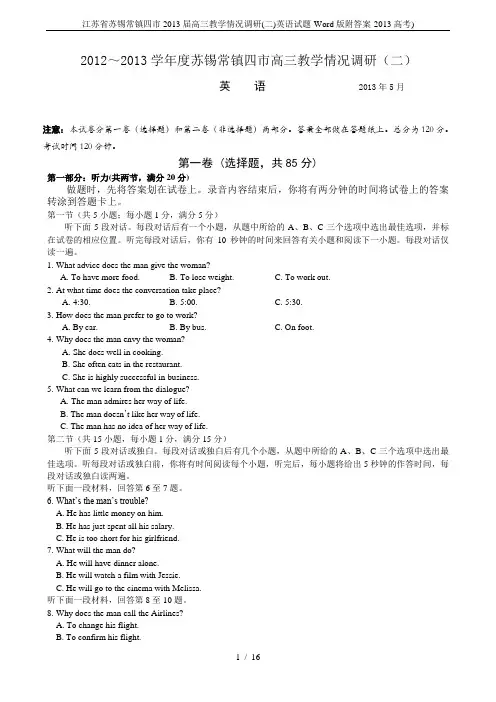
2012~2013学年度苏锡常镇四市高三教学情况调研(二)英语2013年5月注意:本试卷分第一卷(选择题)和第二卷(非选择题)两部分。
答案全部做在答题纸上。
总分为120分。
考试时间120分钟。
第一卷 (选择题,共85分)第一部分:听力(共两节,满分20分)做题时,先将答案划在试卷上。
录音内容结束后,你将有两分钟的时间将试卷上的答案转涂到答题卡上。
第一节(共5小题;每小题1分,满分5分)听下面5段对话。
每段对话后有一个小题,从题中所给的A、B、C三个选项中选出最佳选项,并标在试卷的相应位置。
听完每段对话后,你有10秒钟的时间来回答有关小题和阅读下一小题。
每段对话仅读一遍。
1. What advice does the man give the woman?A. To have more food.B. To lose weight.C. To work out.2. At what time does the conversation take place?A. 4:30.B. 5:00.C. 5:30.3. How does the man prefer to go to work?A. By car.B. By bus.C. On foot.4. Why does the man envy the woman?A. She does well in cooking.B. She often eats in the restaurant.C. She is highly successful in business.5. What can we learn from the dialogue?A. The man admires her way of life.B. The man doesn’t like her way of life.C. The man has no idea of her way of life.第二节(共15小题,每小题1分,满分15分)听下面5段对话或独白。
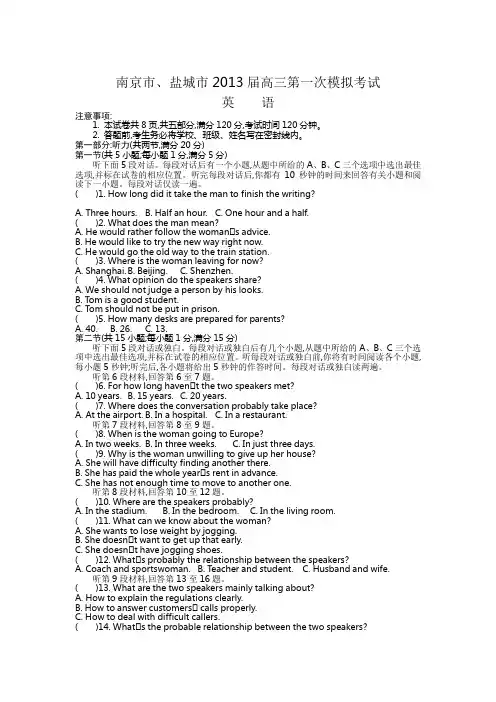
南京市、盐城市2013届高三第一次模拟考试英语注意事项:1.本试卷共8页,共五部分,满分120分,考试时间120分钟。
2.答题前,考生务必将学校、班级、姓名写在密封线内。
第一部分:听力(共两节,满分20分)第一节(共5小题;每小题1分,满分5分)听下面5段对话。
每段对话后有一个小题,从题中所给的A、B、C三个选项中选出最佳选项,并标在试卷的相应位置。
听完每段对话后,你都有10秒钟的时间来回答有关小题和阅读下一小题。
每段对话仅读一遍。
()1.How long did it take the man to finish the writing?A.Three hours.B.Half an hour.C.One hour and a half.()2.What does the man mean?A.He would rather follow the woman s advice.B.He would like to try the new way right now.C.He would go the old way to the train station.()3.Where is the woman leaving for now?A.Shanghai.B.Beijing.C.Shenzhen.()4.What opinion do the speakers share?A.We should not judge a person by his looks.B.Tom is a good student.C.Tom should not be put in prison.()5.How many desks are prepared for parents?A.40.B.26.C.13.第二节(共15小题;每小题1分,满分15分)听下面5段对话或独白。
每段对话或独白后有几个小题,从题中所给的A、B、C三个选项中选出最佳选项,并标在试卷的相应位置。
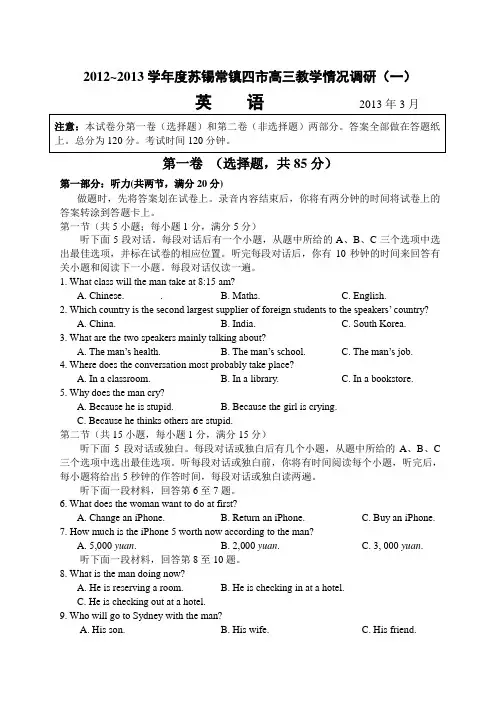
2012~2013学年度苏锡常镇四市高三教学情况调研(一)2013年3月第一卷(选择题,共85分)第一部分:听力(共两节,满分20分)做题时,先将答案划在试卷上。
录音内容结束后,你将有两分钟的时间将试卷上的答案转涂到答题卡上。
第一节(共5小题;每小题1分,满分5分)听下面5段对话。
每段对话后有一个小题,从题中所给的A、B、C三个选项中选出最佳选项,并标在试卷的相应位置。
听完每段对话后,你有10秒钟的时间来回答有关小题和阅读下一小题。
每段对话仅读一遍。
1. What class will the man take at 8:15 am?A. Chinese. .B. Maths.C. English.2. Which country is the second largest supplier of foreign students to the speakers’ coun try?A. China.B. India.C. South Korea.3. What are the two speakers mainly talking about?A. The man’s health.B. The man’s school.C. The man’s job.4. Where does the conversation most probably take place?A. In a classroom.B. In a library.C. In a bookstore.5. Why does the man cry?A. Because he is stupid.B. Because the girl is crying.C. Because he thinks others are stupid.第二节(共15小题,每小题1分,满分15分)听下面5段对话或独白。
每段对话或独白后有几个小题,从题中所给的A、B、C 三个选项中选出最佳选项。
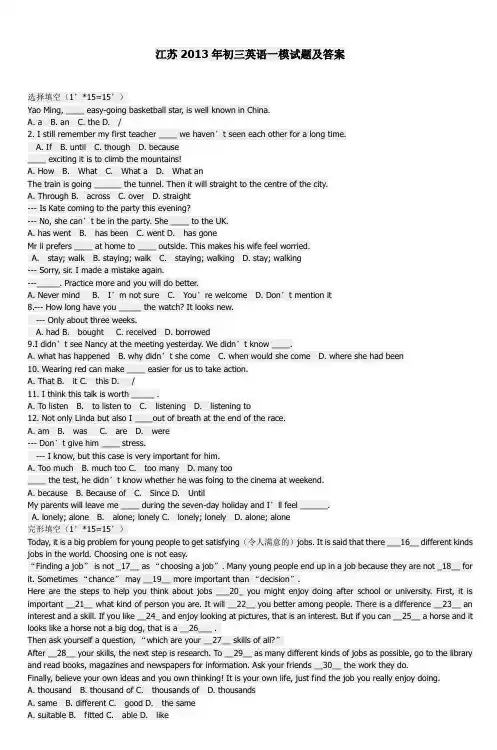
江苏2013年初三英语一模试题及答案选择填空(1’*15=15’)Yao Ming, ____ easy-going basketball star, is well known in China.A. aB. anC. theD. /2. I still remember my first teacher ____ we haven’t seen each other for a long time.A. IfB. untilC. thoughD. because____ exciting it is to climb the mountains!A. HowB. WhatC. What aD. What anThe train is going ______ the tunnel. Then it will straight to the centre of the city.A. ThroughB. acrossC. overD. straight--- Is Kate coming to the party this evening?--- No, she can’t be in the party. She ____ to the UK.A. has wentB. has beenC. wentD. has goneMr li prefers ____ at home to ____ outside. This makes his wife feel worried.A. stay; walkB. staying; walkC. staying; walkingD. stay; walking--- Sorry, sir. I made a mistake again.---_____. Practice more and you will do better.A. Never mindB. I’m not sureC. You’re welcomeD. Don’t mention it8.--- How long have you _____ the watch? It looks new.--- Only about three weeks.A. hadB. boughtC. receivedD. borrowed9.I didn’t see Nancy at the meeting yesterday. We didn’t know ____.A. what has happenedB. why didn’t she comeC. when would she comeD. where she had been10. Wearing red can make ____ easier for us to take action.A. ThatB. itC. thisD. /11. I think this talk is worth _____ .A. To listenB. to listen toC. listeningD. listening to12. Not only Linda but also I ____out of breath at the end of the race.A. amB. wasC. areD. were--- Don’t give him ____ stress.--- I know, but this case is very important for him.A. Too muchB. much tooC. too manyD. many too____ the test, he didn’t know whether he was foing to the cinema at weekend.A. becauseB. Because ofC. SinceD. UntilMy parents will leave me ____ during the seven-day holiday and I’ll feel ______.A. lonely; aloneB. alone; lonelyC. lonely; lonelyD. alone; alone完形填空(1’*15=15’)Today, it is a big problem for young people to get satisfying(令人满意的)jobs. It is said that there ___16__ different kinds jobs in the world. Choosing one is not easy.“Finding a job” is not _17__ as “choosing a job”. Many young people end up in a job because they are not _18__ for it. Sometimes “chance” may __19__ more important than “decision”.Here are the steps to help you think about jobs ___20_ you might enjoy doing after school or university. First, it is important __21__ what kind of person you are. It will __22__ you better among people. There is a difference __23__ an interest and a skill. If you like __24_ and enjoy looking at pictures, that is an interest. But if you can __25__ a horse and it looks like a horse not a big dog, that is a __26___ .Then ask yourself a question, “which are your __27__ skills of all?”After __28__ your skills, the next step is research. To __29__ as many different kinds of jobs as possible, go to the library and read books, magazines and newspapers for information. Ask your friends __30__ the work they do.Finally, believe your own ideas and you own thinking! It is your own life, just find the job you really enjoy doing.A. thousandB. thousand ofC. thousands ofD. thousandsA. sameB. differentC. goodD. the sameA. suitableB. fittedC. ableD. likeA. takeB. beC. haveD. chooseA. butB. whatC. ifD. whetherA. feelB. realizeC. feelingD. to realizeA. helpedB. makesC. makeD. helpingA. bothB. betweenC. fromD. eitherA. artB. musicC. sportsD. actingA. rideB. feedC. drawD. treatA. successB. skillC. hobbyD. factA. goodB. wellC. betterD. bestA. examineB. have examinedC. examiningD. examinedA. find outB. look outC. look forD. look atA. what do they think ofB. how do they think ofC. what they think ofD. how they think of阅读理解(2’*12=24’)AMy father is an astronaut. It’s not easy to be an astronaut’s son. I should be so special and so good at everything I do. Well, to be honest. I often dream about being a hero or doing something special-like saving a child from a burning building. One morning my teacher said there would be a Father’s Day writing competition for the whole school. “ I hope I win the competition in my class,” I said to myself.When I got home, I started to think about what to write.On Thursday, my parents and I went to school. There were so many people in the big hall! My dad looked at me, and I shrugged(耸肩).The third prize was announced and it was not me. The second prize was announced. It was me. I went up to the stage and read what I had written, “My father’s son”. When I finished, dad put his hand on my shoulder and said, “son, this is the happiest moment of my life”.It was the happiest moment of my life, too. Maybe I’ll never be a great hero or win a Nobel(诺贝尔) prize, but it was enough just to be my father’s son.The writer felt it _____ to be the son of a famous person.A. luckyB. naturalC. hardD. pleasantThe write would like to save a child from a burning building because he wants to ______.A. Become an astronautB. become a great heroC. be made school team captainD. be made monitorWhat did the boy probably write in his composition?A. A lot of special things he had dineB. The story of his father’sC. The wonderful time he spent with his fatherD. The experiences his father had in middle school34. What is the best title for the passage?A. My daydreamB. My father’s sonC. My famous fatherD. My happy familyBSimon is a 17-year-old young man, but he was a famous champion(冠军). Everybody in New York University liked this tall, quiet boy. Once he was hurt, everybody in New York University was sorry. People all over the country talked about Simon and often asked, “will he never jump again?” Simon’s mother went to the hospital to see her son. She looked at his broken leg. Then she looked into his eyes. She knew what her son would. “You’re going to jump again, Simon, I know it,” she said. “Everything will be all right.” If Simon hoped to jump again, he would have a lot to do. He began at once. Even in his hospital bed. Simon started to exercise. He used a wheel(轮子) and other metal things. Soon his bed looked like a machine shop! It was May when Simon left the hospital. “is it all right if I go camping this summer?” he asked the doctors. “Yes” the doctors said. “But take it easy on that foot”. Simon took only short walks at first. He was taking it easy on his foot, but not on anything else. He went swimming and did other kinds of exercises. He exercised until his body cried for a rest. Some days later, he exercised a little more. In late summer Simon went back to school. He asked if he could practice with the football team. Football wasn’t his favourite, but he had to get that leg strong again.” He worked hard. “No one pushed him As hard as he pushed himself, said one of his friends. “To see a champion fighting back is a wonderful thing to watch”.35Simon is good at _____.A. swimmingB. studyingC. jumpingD. playing football36. When did Simon leave the hospital?A. In MayB. In AprilC. In MarchD. In June37. Where did Simon start to exercise again?A. In his homeB. In the schoolC. In his hospital bedD. In the playground38. From the passage we know that______.A. Only everybody in New York University liked Simon.B. His mother didn’t know what her son would do.C. His teacher helped him to exercise.D. Simon had a strong personality.CSoon computer and other machine will be able to remember you by looking at your eyes! The program works because everyone’s eyes are different. So in the future you won’t have to remember a number when you want to use a machine or take money out of a bank. You’ll just have to look at the machine and it will be able to tell who you are.The eye-recognition(眼睛识别) program is already being tested in shops and banks. Soon, this technology(技术) will change all other ways of finding out who people are.However, scientists are working on other systems. Machines will soon be able to know you from the shape of your face or hands or even your smell! We already have machines that can tell who you are from your voice or the mark made by your fingers.Eye-recognition is better than other kinds because your eyes don’t changes as you get older, or get dirty like hands or fingers. And even twins have different eyes, so the programs may only be right 51% of the time. In Britain, it was found that 91%of people who had tried it said that they liked the idea of eye-recognition.In the future your computer will be looking at you in the eye. So smile!39. How does the eye-recognition program work?A. You type in your number.B. You say your name.C. You look at the machine.D. You show your ID card.40. Why can the eye-recognition program be up to 94% correct?A. Because eyes hardly change.B. Because the program is widely used around the world.C. Because people like the idea of the program.D. Because hands or fingers can get dirty.41. Which recognition program has been already in use?A. Remembering smells.B. Remembering fingerprints.C. Remembering the shape of faces.D. Remembering eyes.42. Which of the following is TRUE?47. Mr and Mrs Read are always busy. They often leave their children by ______.B)用括号中所给单词的正确形式填空(5’)。
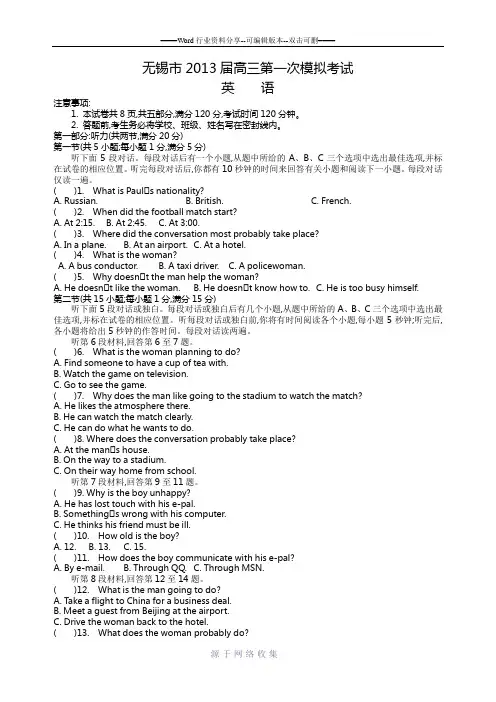
无锡市2013届高三第一次模拟考试英语注意事项:1.本试卷共8页,共五部分,满分120分,考试时间120分钟。
2.答题前,考生务必将学校、班级、姓名写在密封线内。
第一部分:听力(共两节,满分20分)第一节(共5小题;每小题1分,满分5分)听下面5段对话。
每段对话后有一个小题,从题中所给的A、B、C三个选项中选出最佳选项,并标在试卷的相应位置。
听完每段对话后,你都有10秒钟的时间来回答有关小题和阅读下一小题。
每段对话仅读一遍。
()1.What is Paul s nationality?A.Russian.B.British.C.French.()2.When did the football match start?A.At2:15.B.At2:45.C.At3:00.()3.Where did the conversation most probably take place?A.In a plane.B.At an airport.C.At a hotel.()4.What is the woman?A.A bus conductor.B.A taxi driver.C.A policewoman.()5.Why doesn t the man help the woman?A.He doesn t like the woman.B.He doesn t know how to.C.He is too busy himself.第二节(共15小题;每小题1分,满分15分)听下面5段对话或独白。
每段对话或独白后有几个小题,从题中所给的A、B、C三个选项中选出最佳选项,并标在试卷的相应位置。
听每段对话或独白前,你将有时间阅读各个小题,每小题5秒钟;听完后,各小题将给出5秒钟的作答时间。
每段对话读两遍。
听第6段材料,回答第6至7题。
()6.What is the woman planning to do?A.Find someone to have a cup of tea with.B.Watch the game on television.C.Go to see the game.()7.Why does the man like going to the stadium to watch the match?A.He likes the atmosphere there.B.He can watch the match clearly.C.He can do what he wants to do.()8.Where does the conversation probably take place?A.At the man s house.B.On the way to a stadium.C.On their way home from school.听第7段材料,回答第9至11题。

南京市、盐城市2013届高三年级第一次高考模拟考试英语试题第二部分英语知识运用(共两节,满分35分)第一节单项填空(共15小题;每小题1分,满分15分)请认真阅读下面各题,从题中所给的A、B、C、D四个选项中,选出最佳选项,并在答题卡上将该项涂黑。
21. —Tonight‟s negotiation _______ to be a difficult one.—I can‟t agree more. Both sides are stubborn and will fight for their own benefits.A. intendsB. soundsC. promisesD. prepares22. She surprised us all when she resigned so suddenly, _______ she had worked here for more thantwenty years.A. concerningB. supposingC. regardingD. considering23. As is often the case, t he fact that something is cheap doesn‟t _______ mean it‟s of low quality.A. necessarilyB. usuallyC. certainlyD. mostly24. —Haven‟t you completed the building to be used as a library?—Yes. We _______ on it for over ten months.A. workedB. have workedC. are workingD. will have worked25. Chinese writer Mo Yan, _______ the works have been acknowledged by the international literarycommunity, won the Nobel Prize for Literature on Oct. 11, 2012.A. whoseB. thatC. from whichD. of whom26. Most restaurants and cafes have _______ small no-smoking areas but won‟t enforc e the rule.A. set asideB. set outC. set downD. set off27. Scientists have found evidence from their research _______ painful early experiences can makeA. whereB. whatC. thatD. when28. We were stuck at the airport because of the heavy fog, otherwise we _______ here in time forthe conference.A. arrivedB. had arrivedC. would arriveD. would have arrived29. If you drop all your friends because you are in power, _______ are that they will drop you toobecause you are not reliable.A. chancesB. opportunitiesC. questionsD. problems30. —Have you heard anything about whether or not we‟re running a summer camp this year?—No, I haven‟t, and I _______ about that, too.A. wonderB. wonderedC. had wonderedD. have been wondering31. —Do you know the man talking to the headmaster?—A scientist _______ a visit to our school. He will give us a speech on satellite TV tomorrow.A. paysB. payingC. is payingD. having paid32. Laura decided that _______ she might face, she would make any sacrifice to make children inpoor areas happy.A. however a serious challengeB. what a serious challengeC. however serious a challengeD. what serious a challenge33. When _______ comes to an interview day, we‟ve got many things in our minds, such as beingon time and giving proper answers.A. thatB. thisC. itD. one34. Only when you take great delight in reading and begin reading good books _______ thepleasure of reading.A. do you tasteB. you tasteC. you will tasteD. will you taste35. —I really think our teacher‟s work is as good as that of those famous educators.—_______. He has developed his own unique style of teaching.A. That‟s not the pointB. You can say that againC. It counts for nothingD. That‟s great第二节完形填空(共20小题;每小题1分,满分20分)请认真阅读下面短文,从短文后各题所给的A、B、C、D四个选项中,选出最佳选项,并在答题卡上将该项涂黑。
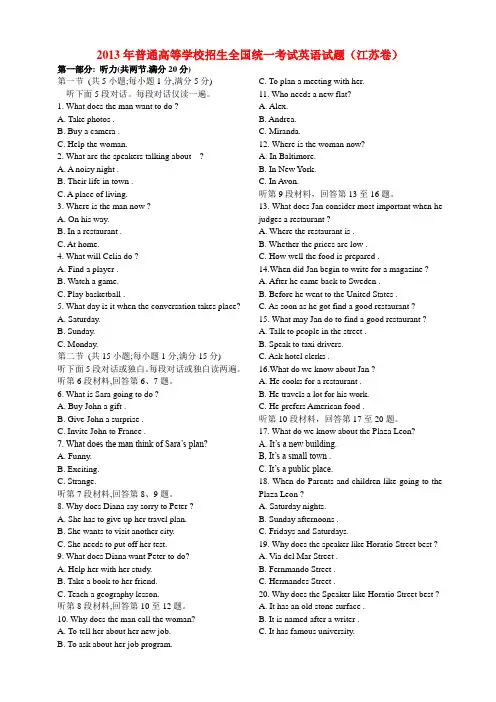
2013年普通高等学校招生全国统一考试英语试题(江苏卷)第一部分: 听力(共两节,满分20分)第一节(共5小题;每小题1分,满分5分)听下面5段对话。
每段对话仅读一遍。
1. What does the man want to do ?A. Take photos .B. Buy a camera .C. Help the woman.2. What are the speakers talking about ?A. A noisy night .B. Their life in town .C. A place of living.3. Where is the man now ?A. On his way.B. In a restaurant .C. At home.4. What will Celia do ?A. Find a player .B. Watch a game.C. Play basketball .5. What day is it when the conversation takes place?A. Saturday.B. Sunday.C. Monday.第二节(共15小题;每小题1分,满分15分)听下面5段对话或独白。
每段对话或独白读两遍。
听第6段材料,回答第6、7题。
6. What is Sara going to do ?A. Buy John a gift .B. Give John a surprise .C. Invite John to France .7. What does the man think of Sara’s plan?A. Funny.B. Exciting.C. Strange.听第7段材料,回答第8、9题。
8. Why does Diana say sorry to Peter ?A. She has to give up her travel plan.B. She wants to visit another city.C. She needs to put off her test.9. What does Diana want Peter to do?A. Help her with her study.B. Take a book to her friend.C. Teach a geography lesson.听第8段材料,回答第10至12题。
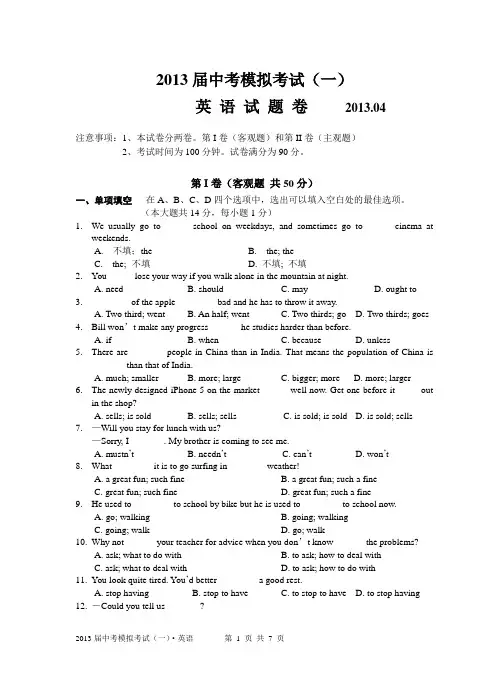
2013届中考模拟考试(一)英语试题卷2013.04注意事项:1、本试卷分两卷。
第I卷(客观题)和第II卷(主观题)2、考试时间为100分钟。
试卷满分为90分。
第Ι卷(客观题共50分)一、单项填空在A、B、C、D四个选项中,选出可以填入空白处的最佳选项。
(本大题共14分,每小题1分)1.We usually go to _____ school on weekdays, and sometimes go to _____ cinema atweekends.A. 不填;theB. the; theC. the; 不填D. 不填; 不填2.You _____ lose your way if you walk alone in the mountain at night.A. needB. shouldC. mayD. ought to3.________ of the apple ________ bad and he has to throw it away.A. Two third; wentB. An half; wentC. Two thirds; goD. Two thirds; goes4.Bill won’t make any progress ______ he studies harder than before.A. ifB. whenC. becauseD. unless5.There are _______ people in China than in India. That means the population of China is_______ than that of India.A. much; smallerB. more; largeC. bigger; moreD. more; larger6.The newly designed iPhone 5 on the market______ well now. Get one before it _____outin the shop?A. sells; is soldB. sells; sellsC. is sold; is soldD. is sold; sells7.—Will you stay for lunch with us?—Sorry, I _______. My brother is coming to see me.A. mustn’tB. needn’tC. can’tD. won’t8.What ________ it is to go surfing in________ weather!A. a great fun; such fineB. a great fun; such a fineC. great fun; such fineD. great fun; such a fine9.He used to ________ to school by bike but he is used to ________ to school now.A. go; walkingB. going; walkingC. going; walkD. go; walk10.Why not ______ your teacher for advice when you don’t know ______ the problems?A. ask; what to do withB. to ask; how to deal withC. ask; what to deal withD. to ask; how to do with11.You look quite tired. You’d better ________ a good rest.A. stop havingB. stop to haveC. to stop to haveD. to stop having12.-Could you tell us _______?-About five minutes.A. how soon will the film endB. how long has the film begunC. how soon the film has overD. how long the film has been on13.Do you feel like _______ to a film or would you rather _______ at home?A. to go; stayB. going; stayingC. going; stayD. going; to stay14.—Thank God. It’s Friday again. A nice weekend! —_______.A. Me tooB. Yes, I’ll be free thenC. That’s all rightD. The same to you二、完型填空先通读下面的短文,掌握其大意,然后在每小题所给的四个选项中,选出可以填入空白处的最佳选项。
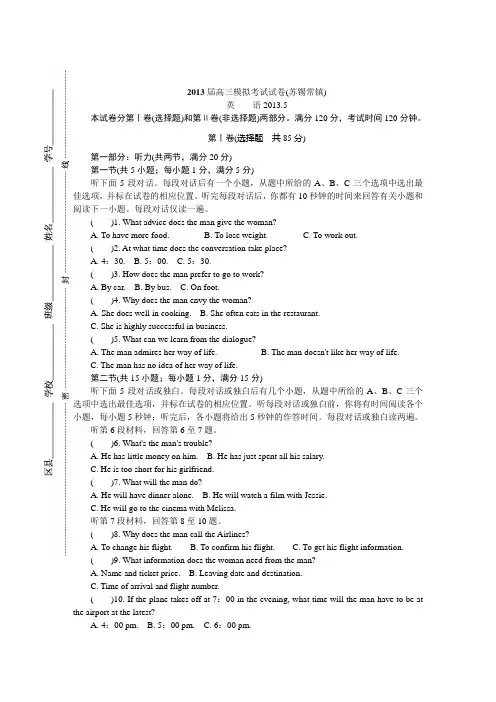
英语2013.5本试卷分第Ⅰ卷(选择题)和第Ⅱ卷(非选择题)两部分。
满分120分,考试时间120分钟。
第Ⅰ卷(选择题共85分)第一部分:听力(共两节,满分20分)第一节(共5小题;每小题1分,满分5分)听下面5段对话。
每段对话后有一个小题,从题中所给的A、B、C三个选项中选出最佳选项,并标在试卷的相应位置。
听完每段对话后,你都有10秒钟的时间来回答有关小题和阅读下一小题。
每段对话仅读一遍。
()1. What advice does the man give the woman?A. To have more food.B. To lose weight.C. To work out.()2. At what time does the conversation take place?A. 4:30.B. 5:00.C. 5:30.()3. How does the man prefer to go to work?A. By car.B. By bus.C. On foot.()4. Why does the man envy the woman?A. She does well in cooking.B. She often eats in the restaurant.C. She is highly successful in business.()5. What can we learn from the dialogue?A. The man admires her way of life.B. The man doesn't like her way of life.C. The man has no idea of her way of life.第二节(共15小题;每小题1分,满分15分)听下面5段对话或独白。
每段对话或独白后有几个小题,从题中所给的A、B、C三个选项中选出最佳选项,并标在试卷的相应位置。
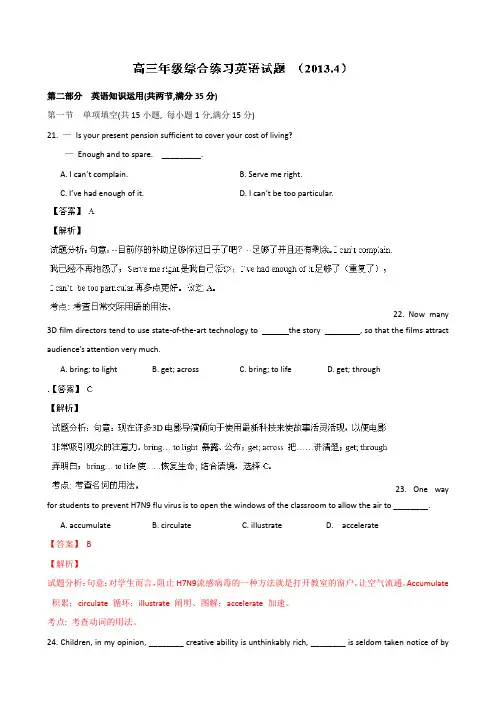
第二部分英语知识运用(共两节,满分35分)第一节单项填空(共15小题, 每小题1分,满分15分)21. —Is your present pension sufficient to cover your cost of living?—Enough and to spare. _________.A. I can’t complain.B. Serve me right.C. I’ve had enough of it.D. I can’t be too particular.22. Now many 3D film directors tend to use state-of-the-art technology to the story , so that the films attract audience’s attention very much.A. bring; to lightB. get; acrossC. bring; to lifeD. get; through23. One way for students to prevent H7N9 flu virus is to open the windows of the classroom to allow the air to ________.A. accumulateB. circulateC. illustrateD. accelerate【答案】B【解析】试题分析:句意:对学生而言,阻止H7N9流感病毒的一种方法就是打开教室的窗户,让空气流通。
Accumulate 积累;circulate 循环;illustrate 阐明、图解;accelerate 加速。
考点: 考查动词的用法。
24. Children, in my opinion, ________ creative ability is unthinkably rich, ________ is seldom taken notice of byus, should be trained in that area.A. which; thatB. whose; whichC. which; whichD. whose; that25. _________ to the association of success with money that the thought of giving up good salary for an idea seems like a little bit crazy.A. Most of us are much accustomedB. So accustomed most of us areC. So accustomed are most of usD. Accustomed as most of us are26._________ the fact that many drivers are ever trained, we cannot stress too much the importance of traffic safety.A. Thanks toB. DespiteC. AsD. Although27. We havegot a general idea of how our new flat will be decorated, but nothing ______ at the moment.A. ambiguousB. ambitiousC. concreteD. permanent28. Until we have discussed all the details, no decision_________ about any new operations.A. will be madeB. is madeC. is being madeD. has been made29. You can spend your free time in our library. There is a reading room more than 600 students.A. seatsB. to be seatedC. seatedD. seating30. “Theinterest ________ be divided into four parts, according to the contract between the two sides,” declared the judge.A. mayB. shouldC. canD. shall31. —I do enjoy my present job as an engineer.—Well,I would also be an engineer if I my major when I was at college.A. could have changedB. should changeC. hadn't changedD. were to change32. —Why did he say so?—Sorry, I don’t understand he has said means.A. what allB. that allC. all whatD. that33. —Anyfashion news about skirts?—Yes. This season’s short skirts have gained popularity now, although they to be shocking at first.A. have been thoughtB. were thoughtC. are thoughtD. had thought34. I am afraid that Mrs. Black doesn’t believe her son is able to design such a complicated machine,?A. does sheB. aren’t IC. is heD. isn’t he35. —I've decided to go back to school for some training in programming.—. When would you like to start?A. Good for youB. Up to youC. You can have itD. I got you考点: 考查日常交际用语的用法。
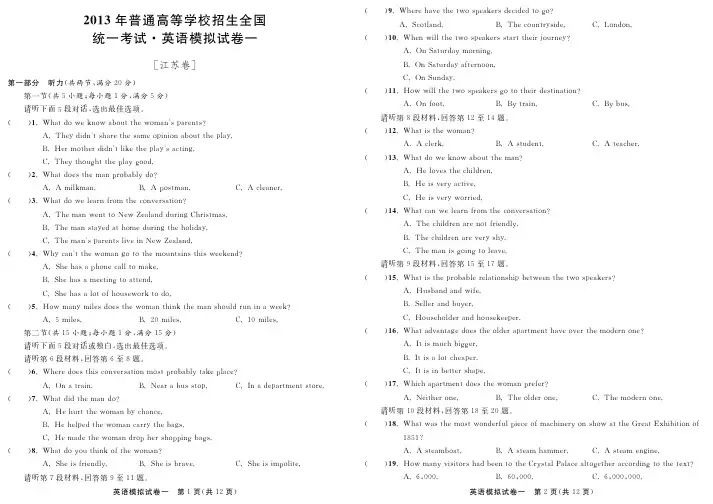
英语模拟试卷一 第! 页共!"页 !"#$年普通高等学校招生全国统一考试 英语模拟试卷一江苏卷第一部分 听力 共两节 满分"#分第一节 共$小题 每小题!分 满分$分 请听下面$段对话 选出最佳选项#%&'()*+,-./+,(0+1))'-,+2(/345(6-/)4 7%8'-9*:*/3)4'(6-)'-4(2-+5:/:+/(0+1))'-5;(9%<%=-62+)'-6*:*/3);:.-)'-5;(934(>):/?%@%8'-9)'+1?'))'-5;(9?++*% !%&'()*+-4)'-2(/56+0(0;9*+7%72:;.2(/%<%75+4)2(/%@%7>;-(/-6%$%&'()*+,-;-(6/A 6+2)'->+/B -64():+/ 7%8'-2(/,-/))+C -,D -(;(/**16:/?@'6:4)2(4%<%8'-2(/4)(9-*()'+2-*16:/?)'-'+;:*(9%@%8'-2(/345(6-/)4;:B -:/C -,D -(;(/*%%%&'9>(/3))'-,+2(/?+)+)'-2+1/)(:/4)':4,--.-/* 7%E '-'(4(5'+/->(;;)+2(.-%<%E '-'(4(2--):/?)+())-/*%@%E '-'(4(;+)+A '+14-,+6.)+*+%&%=+,2(/92:;-4*+-4)'-,+2(/)':/.)'-2(/4'+1;*61/:/(,--. 7%$2:;-4%<%"#2:;-4%@%!#2:;-4%第二节 共!$小题 每小题!分 满分!$分 请听下面$段对话或独白 选出最佳选项 请听第F 段材料 回答第F 至G 题'%&'-6-*+-4)':4>+/B -64():+/2+4)56+0(0;9)(.-5;(>- 7%H /()6(:/%<%C -(6(0144)+5%@%I /(*-5(6)2-/)4)+6-%(%&'()*:*)'-2(/*+ 7%=-'16))'-,+2(/09>'(/>-%<%=-'-;5-*)'-,+2(/>(669)'-0(?4%@%=-2(*-)'-,+2(/*6+5'-64'+55:/?0(?4%)%&'()*+9+1)':/.+A )'-,+2(/ 7%E '-:4A 6:-/*;9%<%E '-:406(B -%@%E '-:4:25+;:)-%请听第J 段材料 回答第K 至!!题英语模拟试卷一 第" 页共!"页 *%&'-6-'(B -)'-),+45-(.-64*->:*-*)+?+ 7%E >+);(/*%<%8'->+1/)694:*-%@%L +/*+/%#"%&'-/,:;;)'-),+45-(.-644)(6))'-:6M +16/-97%H /E ()16*(92+6/:/?%<%H /E ()16*(9(A )-6/++/%@%H /E 1/*(9% ##%=+,,:;;)'-),+45-(.-64?+)+)'-:6*-4):/():+/ 7%H /A ++)%<%<9)6(:/%@%<9014%请听第G 段材料 回答第!"至!N 题#!%&'():4)'-,+2(/ 7%7>;-6.%<%74)1*-/)%@%7)-(>'-6%#$%&'()*+,-./+,(0+1))'-2(/ 7%=-;+B -4)'->':;*6-/%<%=-:4B -69(>):B -%@%=-:4B -69,+66:-*%#%%&'()>(/,-;-(6/A 6+2)'->+/B -64():+/ 7%8'->':;*6-/(6-/+)A 6:-/*;9%<%8'->':;*6-/(6-B -694'9%@%8'-2(/:4?+:/?)+;-(B -%请听第K 段材料 回答第!$至!J 题#&%&'():4)'-56+0(0;-6-;():+/4':50-),--/)'-),+45-(.-64 7%=140(/*(/*,:A -%<%E -;;-6(/*019-6%@%=+14-'+;*-6(/*'+14-.--5-6% #'%&'()(*B (/)(?-*+-4)'-+;*-6(5(6)2-/)'(B -+B -6)'-2+*-6/+/- 7%I ):421>'0:??-6%<%I ):4(;+)>'-(5-6%@%I ):4:/0-))-64'(5-% #(%&':>'(5(6)2-/)*+-4)'-,+2(/56-A -6 7%C -:)'-6+/-%<%8'-+;*-6+/-%@%8'-2+*-6/+/-%请听第!#段材料 回答第!G 至"#题#)%&'(),(4)'-2+4),+/*-6A 1;5:->-+A2(>':/-69+/4'+,())'-O 6-()P Q ':0:):+/+A !G $!7%74)-(20+()%<%74)-(2'(22-6%@%74)-(2-/?:/-% #*%=+,2(/9B :4:)+64'(*0--/)+)'-@694)(;R (;(>-(;)+?-)'-6(>>+6*:/?)+)'-)-Q ) 7%F ###%<%F # ###%@%F ### ###%英语模拟试卷一 第S 页!共!"页"! "!"%&'()*-4)6+9-*)'-@694)(;R (;(>-:/!K S F (7%7A :6-%<%7A ;++*%@%7/-(6)'T1(.-%第二部分 英语知识运用!共两节%满分S $分"第一节 单项选择!共!$小题&每小题!分%满分!$分"从7)<)@)U 四个选项中%选出可以填入空白处的最佳选项'! "!#%*U :*9+1-/M +9)'-5(6)9;(4)/:?')(* +P B -690+*9,(4:/':?'45:6:)4% 7%C +)(;:));-<%C +)(0:)@%I >+1;*/3)(?6--2+6-U%I *+/3)0-;:-B -4+! "!!%V (/95-+5;-(6-:/ A (B +16+A )'-B :-,)'() 2-*:((6-)+0;(2-A +64)(6):/?)'-612+64%7%)'-&不填<%不填&不填@%)'-&)'-U%不填&)'-! "!$%E (;;9:4B -69 (/*4'-34(;,(94;-)):/?9+1./+,,'()344'-34)':/.:/?%7%>+/4-6B ():B -<%4)6(:?')A +6,(6*@%6-(4+/(0;-U%(20:):+14! "!%%L :1L -::/4:4)-*)'()'-2-6-;9*:*,'()-B -690+*9,+1;*'(B -*+/-(/*4)6+/?;9+0M ->)-* ('-6+%7%>(;;:/?<%)+>(;;:/?@%0-:/?>(;;-*U%)+0-:/?>(;;-*! "!&%7;;294:4)-634'(6*,+6. :/)'--/*&4'-A :/(;;9?+)(R 'U:/2-*:>:/-%7%5(:*+A A <%?(B -+1)@%06+.-*+,/U%A (*-*(,(9! "!'%*I )340-?://:/?)+>;-(615/+,%&'()4'(;;,-*+)':4(A )-6/++/(*&- ?++1)A +6(,(;.09)'-6:B -6:A 9+1*+/3)2:/*%7%,+1;*<%214)@%>+1;*U%,:;;! "!(%8'-@P H 51)56-4416-+/)'-2(/(?-64())'-4(;-4>+/A -6-/>-%4+)'-9% %51)56-4416-+/;+>(;014:/-445-+5;-%7%:/B (:/<%:/6-;:-A @%:/)16/U%:/):2-! "!)%7/9+/--Q >-5)56+A -44:+/(;-Q 5-6)4,(4A +60:**-/ >;+4-)+)'-0(?A+1/*0-':/*)'-*14)0:/%7%?-)):/?<%)+?-)@%?+)U%)+?-)):/?! "!*%76-?1;():+/'(46->-/);90--/6-;-(4-*:/)'-4>'++; 4)1*-/)44'(;;/+))(.-英语模拟试卷一 第N 页!共!"页">-;;5'+/-4:/)+)'->;(446++2%7%)'()<%,'-6-@%,'+4-U%,':>'! "$"%&-3;;06:/?)'-2(/)+>+16),'-/-/+1?'-B :*-/>-:4 %7%(/(;94-*<%(>>121;()-*@%(>':-B -*U%())(>'-*! "$#%I ),(4(9-(6;()-6 )'-B :;;(?-646-(;:W -*)'())'-9,-6->'-()-*+A (;;)'-:62+/-9%7%0-A +6-<%,'-/@%(A )-6U%)'()! "$!%*&'9*:*/3)9+1(/4,-62-,'-/I >(;;-*9+1)':42+6/:/?(*H '%4+669%I A +6(/-,M +0%7%:/)-6B :-,-*<%,(4:/)-6B :-,:/?@%,(4:/)-6B :-,-*U%,(40-:/?:/)-6B :-,-*! "$$%X +1'(B -)+A +;;+,)'->+66->) )+41>>--*:/)'--Q 5-6:2-/)%7%56+>-44<%56+>-*16-@%:/*:>():+/U%:;;14)6():+/! "$%% ,+66:-4Y ()9B -6921>',(4)'()'-6212'(40--/+1)+A >+/*:):+/6->-/);9%7%&'+<%&':>'@%&'()U%8'()! "$&%8'+1?',-(6-A (6(,(9A6+2+161/>;-%,-B :4:)':2 %7%('-(*+A ):2-<%A +6():2-@%A 6+2):2-)+):2-U%())'-4(2-):2-第二节 完形填空!共"#小题&每小题!分%满分"#分"阅读下面短文%从短文后各题所给的四个选项!7)<)@和U "中%选出可以填入空白处的最佳选项'+,-./0/1V 9*(**:-*;(4)9-(6%X +1>(/56+0(0;9:2(?:/-)'-A 614)6():+/!沮丧"%)'- $' %)'-1/-Q 5->)-*A ;++*+A )-(64)'()'(B -A :;;-*)'-),-;B -2+/)'44:/>-)'-/%&:)'':2 $( %I '(*)+0-:/>'(6?-+A A (2:;9:441-4%I ) $) )'()I '(*)+0-)'-?6+,/15%7;;)'6+1?'29;:A -29A ()'-6'(* $* 0--/4)-55:/?(,(9A 6+22-%C +):/(/-?;->)A 1;!疏忽的",(9%01):/(,(9)'().-5)2- %" %&'-/I )++.29A :64)0(094)-54%'-,+1;*'(B - %# 2-%8'-/-Q )):2-I %! %'-'-;*+1)':4'(/*4(/*%(4I2+B -*A +6,(6*%'-)++.(4)-50(>.(/*I )++.(/+)'-6 %$ +英语模拟试卷一 第$ 页!共!"页"I /)'-+;*%>+;*%510;:>4,:22:/?0()'4I 4,(2)+,(6*4)'-*--5-/*%4(A -:/)'- %% )'()U (*,(46:?'):/A 6+/)%0(>.:/?(,(9A 6+22- %& I >+25;-)-*)'()A :64);-/?)'%=-'-;*)'-4-()+A290:>9>;-1/):;'-)'+1?')I,(4 %' %7/*)'-/%,:)'+1)2--B -/ %( :)%'-;-)?+(/*4)-55-*(,(9%V (/9):2-4%)'6+1?'29 %) )--/(?-9-(64%U (*,+1;*416B -929;()-4)*:4(4)-6(/*?+6-*:/)'- %* %)'-/'-3*,(;.(,(9(/*;-(B -2-%(4'(2-*(/*-20(66(44-*%)+ &" :)+6;-(6/A 6+2:)%&'-/29+,/>':;*6-/>(2-(;+/?'-,(4/3) &# )+)-;;2-'+,'-)'+1?')I4'+1;* &! )'-2%8'-/'-,+1;*4'61?(/*0(>.(,(9,:)')'-,+6*4%,<1):)349+16 &$ %-C +,%I 32('140(/*%(A ()'-6%(/*(?6(/*A ()'-6%I,(4(;;+A )'()0-A +6-U (**:-*%I ;:.-)+)':/.%:/+16):2-)+?-)'-6%'-3* &% 2-(;;'->+1;*(0+1)0-:/?( && 2(/;:.-':2%Z 6+2)'()5+:/)+/:),(4(;;15)+2-%%%4+'-4)-55-*(,(9%! "$'%7%>+/A :*-/>-<%5():-/>-@%*(/?-6U%(/?-6! "$(%7%,-(.<%,+1/*-*@%?+/-U%4:>.! "$)%7%2-(/)<%(//+1/>-*@%6-5+6)-*U%56+B -*! "$*%7%+/>-<%4):;;@%(;,(94U%(;6-(*9! "%"%7%6-(>':/?+1)<%2+B :/?A +6,(6*@%4-)):/?+A A U%?-)):/?15! "%#%7%(>>-5)-*<%:/B :)-*@%514'-*U%>(1?')! "%!%7%)6:-*<%42:;-*@%4)+55-*U%(66:B -*! "%$%7%4-()<%4)-5@%>'(/>-U%)-4)! "%%%7%./+,;-*?-<%*6-(2@%5;(/U%56+2:4-! "%&%7%:A <%01)@%(4U%)'+1?'! "%'%7%A 6--<%>(;2@%A 1;;U%6-(*9! "%(%7%6-A 14:/?<%6-(;:W :/?@%'-(6:/?U%?(:/:/?! "%)%7%>+/A 14-*<%-Q >:):/?@%,+/*-6A 1;U%1/0-;:-B (0;-! "%*%7%2:/*<%'(/*@%A (>-U%2+1)'! "&"%7%56-B -/)<%6-*1>-@%*+10)U%A :Q ! "&#%7%4;+,<%4)15:*@%/-6B +14U%0(*! "&!%7%6-45->)<%6(:4-@%A --*U%,(6/! "&$%7%*:4>+B -69<%2-2+69@%56-5(6():+/U%*->:4:+/! "&%%7%(,(6*-*<%;-/)@%)(1?')U%5(:*! "&&%7%'-(;)'9<%?++*@%5+;:)-U%4)6:>)第三部分 阅读理解!共!$小题&每小题"分%满分S #分"阅读下列短文%从每题所给的四个选项!7)<)@和U "中%选出最佳选项'2I ))++.2-4-B -6(;9-(64)+6-(;:W -)'()290;(>.:40-(1):A 1;(/*I '(B -(>>-5)-*)'-A (>))'()英语模拟试卷一 第F 页!共!"页":/*--*290;(>.:40-(1):A 1;/+,%8':44.:/I,(4:/A +64+2(/99-(64*-)-62:/-*294-;A,+6)'%I '(*4+2(/9A (>)+64,(?(:/4)-2-:/292:/*,'-/I,(4(;:));-?:6;%I,(4()(;;%)':/%*(6.4.://-*?:6;,:)'(?(5)++)'42:;-%O 6+,:/?15%)'-+/;96+;-2+*-;)'()I'(*,(4292+)'-6%(0-(1):A 1;06+,/(/**--5>+25;-Q :+/!肤色"%I )34(2(W :/?'+,I >+1;*A :/*0-(1)9:/292+)'-634>+25;-Q :+/01)/+)29+,/%H /-+A)'-2+4)+1)4)(/*:/?2-2+6:-4+A 29>':;*'++*:4)'-,+6*,H '%4'-:44+>1)-A +6(*(6.4.://-*;:));-?:6;%-R -+5;-45+.-(4:A I ,(4/3):/)'-6++2%(4:A I >+1;*/3)'-(6%Z 6+2(9+1/?(?-%I A -;)(4'(2-*)'()290;(>.,(4/3)?++*-/+1?'%4+I 016:-*294-;A :/0++.4)+4)(9(,(9A 6+2)'-2:66+6%I ./-,)'()29-*1>():+/,+1;*(/*>+1;*)(.-2-A 16)'-6)'(/29;++.4%I4)+55-*,()>':/?8[%(04+60-*:/294)1*:-4(/*I ,(4'(559,:)'29*->:4:+/%C +,I '(B -0--/(*2:))-*)+29:*-(;@+55:/E )()-\/:B -64:)9%,':>':4A +6)'-0;(>.4)1*-/)4(/*'(4(;+/?':4)+69%I ),(4/3)1/):;I,(4()(?-!F )'()I +A A :>:(;;9*->:*-*)+A :Q29*--56++)-*:441-(0+1)29*--5>+25;-Q :+/%I '(*0--/06(:/,(4'-*)+4104>6:0-)+)'-P 16+5-(/4)(/*(6*+A 0-(1)9A +64+2(/99-(64%I/+;+/?-6(>>-5))':44)(/*(6*%0->(14-I4-)29+,/%V 90;(>.:40-(1):A 1;:/>;1*:/?29A 1;;;:54%)'-,:*-/-44+A /+4-%(/*)'-:/)-/4:)9!明亮"+A29-9-4%I 0-;:-B -)'())'-6-(6-5;-/)9+A 0-(1):A 1;*(6.4.://-*,+2-/:/)'-,+6;*%! "&'%&'-/)'-(1)'+6,(49+1/?%4'- %7%6-(;:W -*)'-:25+6)(/>-+A ?++*2-2+69<%*:*/3)2:/*+)'-644(9:/?4'-,(40;(>.@%(>>-5)-*)'-P 16+5-(/4)(/*(6*+A 0-(1)9U%*:*/3))':/.'-62+)'-6,(4B -690-(1):A 1;! "&(%=+,*:*)'-(1)'+606-(.(,(9A6+2'-61/4():4A :-*;++.4:/'-6>':;*'++*(7%E '-)16/-*'-6())-/):+/)+'-64)1*:-4%<%E '-,()>'-*8[(/*6-(*0++.4%@%E '-())-/*-*(4>'++;A +60;(>.4%U%E '-06+.-(;;'-62:66+64%! "&)%8'-(1)'+6,6:)-4)'-)-Q )2(:/;9)+)-;;6-(*-64 %7%)'->'(/?-+A '-6()):)1*-4)+,(6*'-6>+25;-Q :+/<%B (6:-*4)(/*(6*4+A 0-(1)9:/*:A A -6-/)5-6:+*4@%'+,'-6(55-(6(/>-'-;5-*'-6)+41>>--*U%,'94'-)':/.4'-60;(>.:40-(1):A 1;345/65,7-889:/8871/:T 1->+20:/():+/+A 9+?(%*(/>-(/*2(6):(;(6)4)->'/:T 1-4%C :(:4(/-,A +62+A A :)/-44*-4:?/-*A +65-+5;-+A (;;A :)/-44;-B -;4)++5-/15)'-:60+*9(/*6-;(Q %英语模拟试卷一 第J 页!共!"页"&'-/.P B -69&-*/-4*(9$ F 5%2%@+4).!##!"#$A +6+/->;(44%$##!"#$A +64:Q @+/)(>).!S $]""K K ]S J "N&'-6-.U]!Z^:/Q :191(/75(6)2-/)%_:/?Z 1@1/D '+/?L 1%@'(+9(/?U :4)6:>);<-=->?-,/9<@-7,A 6B A @-7R (6)+A)'->;+4:/?>-6-2+/9A +6)'-!!)',V --):/<-:M :/?-76)4Z -4):B (;%)'-@':/(C ():+/(;<(;;-),:;;0-5-6A +62:/?%&'(')*'+#,&-'$+./0.-'$%+/-+A )'-2+4)41>>-44A 1;A 1;;`;-/?)'@':/-4-0(;;-)4%&'-/.V (9"$%J .S #5%2%@+4).G # !%#G #!"#$@+/)(>).F N !J ]J G N $%5+/95:(+-/ '+)2(:;%>+2&'-6-.R +;9R ;(W (%!NU +/?W ':2-/C (/*(M :-%U +/?>'-/?U :4)6:>)+,C >-7,D A 9E@+;;-?-0(/*4L (4[-?(4%E )6(/?-^1;9%&-)E (/*%R +4'(/?>1/(/*O (/6(+U :(/)(:,:;;)(.-)'-4)(?-()U `"")+4'+,4+2-+A )'-0-4))(;-/)%&:)'2(/9+A<-:M :/?340-4)1/*-6?6+1/*0(/*4?-)):/?)'-:64)(6)()U `""%:)34(5;(>-)+-Q 5-6:-/>-/-,4+1/*4%A (>-4(/*5-6A +62(/>-4:/45:6-*09)'->:)9349+1/?-4))(;-/)%&'-/.V (9"J %G .S #5%2%@+4)."#!"#$@+/)(>).F "F $]S !J J&'-6-.U]""%"N "@'-/?A 1L 1%=(:*:(/U :4)6:>)+.-->>/,57F ,A 70<--:8-8'-45--**():/?:/*14)69:4/+)/-,:/@':/(%7;;45--**():/?:4)'-4(2-.42(;;)(0;-4%5;-(4(/)-/B :6+/2-/)%/-6B +145-+5;-%8'-45--**():/?,+/,'--;4-:4(/-,A +62+A45--**():/?%8'-*-)(:;4.@':/-4-6:>.`4'(,4!人力车",:;;*6:B -9+1(6+1/*)'-6+2(/):>5;(>-4()=+1'(:L (.-%4)+55:/?)+2(.-(>'(/?-%8':4)6(*:):+/(;()2+45'-6-,:;;06:/?2+6-6+2(/>-)+)'-+;*%0+6:/?45--**():/?%&'-/.^1/-$%" N 5%2%@+4).!$#!"#$!6:>.4'(,4(/*0(6:/>;1*-*"&'-6-.=+1'(:L (.-! "&*%I A (>+15;-,(/))+())-/*),+C :(A :)/-44>;(44-4%)'-9/--*)+5(9 %7%!##!"#$<%"##!"#$@%S ##!"#$U%N ##!"#$! "'"%&':>'+A )'-A +;;+,:/?(0+1))'-45--**():/?,+/,'--;4-:48a \P (7%I ):4/+)/-,:/@':/(%英语模拟试卷一 第G 页!共!"页"<%I );(4)4(,'+;-*(9+/^1/-$%@%I ):441:)(0;-A +6/-6B +145-+5;-(/*+;*5-+5;-%U%I ),:;;/+)>+4)5-+5;--Q )6(2+/-9)+)(.-6:>.4'(,4%! "'#%&':>'+A )'-A +;;+,:/?(>):B :):-4>(/9+1())-/*:A 9+1(6-(B (:;(0;-+/)'--B -/:/?+A V (9"J (7%E )1*-/)6+>.%<%@':/(C ():+/(;<(;;-)%@%C :(A :)/-44>;(44%U%E 5--**():/?,+/,'--;4-%! "'!%I A 9+1,(/))+-/M +9)'-0(;;-)5-6A +62(/>-%9+14'+1;*?+)+ %7%U]!Z^:/Q :191(/75(6)2-/)<%=+1'(:L (.-@%R +;9R ;(W (U%U]""GC +)(;;>+/412-644'(6-)'-4(2-()):)1*-4)+,(6*(/:2(;>;+/:/?%,':>'>(/0-4--/:/)'-;()-4)6-4-(6>'A 6+2E -(/Z +Q %Y (/4(4E )()-\/:B -64:)956+A -44+6%V 1>'+AZ +Q 346-4-(6>'A +>14-4+/>+/412-634()):)1*-4)+,(6*A ++*4(A -)9%=-,+6.-*,:)'E '+/*(7/*-64+/%(6->-/)2(4)-634?6(*1()-%)+-Q 5;+6->+/412-634()):)1*-4)+,(6*>;+/-*(/:2(;4%,&-36-:/)-6-4)-*:/A :/*:/?+1)'+,*:A A -6-/)?6+154+A >+/412-646-(>))+56+*1>)4A 6+2>;+/-*(/:2(;4%-Z +Q4(:*%,&-36-(;4+:/)-6-4)-*:/'+,)'+4-6-(>):+/4*:A A -6-*0-),--/>+1/`)6:-4%-Z +Q(/*7/*-64+/416B -9-*Y (/4(4E )()-1/*-6?6(*1()-4:/(?6:>1;)16-%P /?;:4'(/*4+>:+;+?9>;(44-4%8'-9(;4+416B -9-*(?6:>1;)16-4)1*-/)4()\/:B -64:)9@+;;-?-U 10;:/:/I 6-`;(/*(/*P >+;-E 15-6:-16-*37?6:>1;)16-:/R 165(/%Z 6(/>-%8'-416B -9(4.-*5(6):>:5(/)4!参与者"(0+1))'-:65+44:0:;:)9+A 019:/?(/*-():/?2-()(/*+)'-656+*1>)4A 6+2>;+/-*(/:2(;4%a -41;)44'+,-*)'()72-6:>(/4,-6-2+6-(>>-5):/?+A>;+/-*56+*1>)4)'(/P 16+5-(/4%H )'-6A :/*:/?4:/>;1*-. E )1*-/)4:/I 6-;(/*(/*Z 6(/>-,-6-;-44;:.-;9)+>+/412->;+/-*56+*1>)4)'(/Y (/4(4`E )()-4)1*-/)4%7)Y (/4(4E )()-%4+>:+;+?9(/*P /?;:4'4)1*-/)4,-6-;-44;:.-;9)+>+/412->;+/-*56+*1>)4)'(/(?6:>1;)16-4)1*-/)4% R (6):>:5(/)4,-6-2+6-;:.-;9)+>+/412->;+/-*56+*1>)4(A )-6;-(6/:/?)'()>;+/-*(/:2(;56+*1>)4'(B -/+4(A -)96:4.%V +6-+A)'-P 16+5-(/4)1*-/)4,-6->+/>-6/-*(0+1)>;+/:/?A 6+2(2+6(;5-645->):B -%,':;-)'-72-6:>(/4)1*-/)4,-6-2+6->+/>-6/-*(0+1)A ++*4(A -)9%8'-4)6-/?)'+A +55+4:):+/英语模拟试卷一 第K 页!共!"页")+>;+/:/?,(421>'4)6+/?-6A +6)'+4-,'+2+6(;;9+55+4-*>;+/:/?)'(/A +6)'+4-,'++55+4-*:)A +6A ++*4(A -)9>+/>-6/4%8'-416B -9(;4+A +1/*)'(),+2-/,-6-;-44;:.-;9)+019>;+/-*56+*1>)4%(/*5-+5;-A (2:;:(6,:)'4>:-/>-,-6-2+6-(>>-5):/?+A >;+/-*56+*1>)4%,a -41;)441??-4))'()(;(6?-/120-6+A 5-+5;-*+'(B ->+/>-6/4(0+1)>;+/:/?A 6+2(2+6(;5-645->):B -%-Z +Q4(:*%,I )3;;0-:25+6)(/):A )'-4-56+*1>)4>+2-)+2(6.-)0->(14-,-,+1;*-Q 5->))+4--(;(6?-/120-6+A 5-+5;-(B +:*:/?)'-2%-! "'$%8'-5(6):>:5(/)4:/E -(/Z +Q 34416B -9,-6-2(:/;9 %7%>+;;-(?1-4+A E -(/Z +Q <%4)1*-/)4:/)'6--*:A A -6-/)5;(>-4@%>+/412-64:/)-6-4)-*:/>;+/-*56+*1>)4U%5-+5;-+A *:A A -6-/)56+A -44:+/4:/)'6-->+1/)6:-4! "'%%&':>'+A )'-A +;;+,:/?:48a \P(0+1))'-5+44:0:;:)9+A 019:/?>;+/-*56+*1>)4(7%Z -2(;->+/412-64 V (;->+/412-64%<%I 6:4'4)1*-/)4 Y(/4(4`4)()-4)1*-/)4%@%P /?;:4'`2(M +6-*4)1*-/)4 7?6:>1;)16-`2(M +6-*4)1*-/)4%U%7?6:>1;)16-`2(M +6-*4)1*-/)4 E +>:+;+?9`2(M+6-*4)1*-/)4%! "'&%7>>+6*:/?)+)'-416B -9%,':>'+A)'-A +;;+,:/?2(9(A A ->)>+/412-643()):)1*-4)+,(6*>;+/-*56+*1>)4(7%8'-)95-+A >;+/-*56+*1>)4%<%8'-4(A -)9+A >;+/-*56+*1>)4%@%8'-56:>-+A >;+/-*56+*1>)4%U%8'-)(4)-+A >;+/-*56+*1>)4%! "''%I )>(/0-:/A -66-*)'()E -(/Z +Q 34416B -96-41;)4,:;;'-;5 %7%;-(6/2+6-(0+1)>;+/-*56+*1>)4<%2(.->;+/-*56+*1>)421>'4(A -6@%56-*:>))'-2(6.-)+A >;+/-*56+*1>)4U%*-B -;+5/-,)95-4+A >;+/-*56+*1>)4?8'-=+5-*:(2+/*:4(/1/141(;0;1-`?6(956->:+144)+/-)'():40-;:-B -*)+'(B -0--/2:/-*:/O +;>+/*(%I /*:(%8'-Z 6-/>'M -,-;-6^-(/`<(5):4)-8(B -6/:-60+1?')(!!"`>(6()!克拉"4)+/-%,':>''-06+1?')'+2-)+Z 6(/>-%=:4)+6:(/40-;:-B -)'()Y :/?L +1:4 516>'(4-*)'-*:(2+/*:/!F F G %8'-*:(2+/*,(4-B -/)1(;;96->1)%(/*(;(6?-5(6)+A :)%>(;;-*)'-Z 6-/>'<;1-%*:4(55-(6-*:/(6+00-69:/!J K "*16:/?)'-Z 6-/>'a -B +;1):+/%C ++/-./+,4A +6>-6)(:/)'-5()'+A )'-*:(2+/*(A )-6)'-6+00-69%I /!G !"%'+,-B -6%:),(46-5+6)-*)'()(L +/*+/*:(2+/*4-;;-6'(*(;(6?-0;1-*:(2+/*%P Q 5-6)40-;:-B -*)'():),(4)'-Z 6-/>'<;1-(/*)'():)'(*0--/6->1)%L ()-6%Y :/?O -+6?- +AP /?;(/*+,/-*)'-英语模拟试卷一 第!#页 共!"页 *:(2+/* ,':>',(44+;*(A )-6'-*:-*%<9!G S K )'-4)+/-0-;+/?-*)+=-/69R ':;:5=+5- (L +/*+/0(/.-6%&':;-=+5-'(*)'-4)+/- :),(4/(2-*)'-=+5-*:(2+/*%a -;():B -4:/'-6:)-* 继承 )'-*:(2+/*(A )-6=+5-34*-()'%I ),(45(44-*(;+/?)'6+1?'4-B -6(;?-/-6():+/4,'-/L +6*Z 6(/>:4=+5-*->:*-*)+4-;;)'-*:(2+/*)+5(9+A A ':4*-0)4:/!K #!%8'-/-Q )+,/-6)++.:))+R (6:4%I ),(44+;*(/*)'-/6-4+;*)+R :-66-@(6):-6 (A (2+14M -,-;-6%I /!K !" '-4+;*:))+PB -;9/&(;4'V >L -(/ (,-(;)'9,+2(/:/&(4':/?)+/U%@% ,'+;()-6'(*:)4-):/(/->.;(>-%I /!K N K (A )-6V 64%V >L -(/34*-()' )'-=+5-*:(2+/*,(44+;*)+(,-;;`./+,/M -,-;-6/(2-*=(669&:/4)+/%&:/4)+/-Q ':0:)-*)'-A (2+14*:(2+/*()2(/9-B -/)4 01)'-/-B -64+;*:)%I /4)-(* '-*->:*-*)+*+/()-:))+)'-E 2:)'4+/:(/I /4):)1):+/:/!K $G %8'-E 2:)'4+/:(/I /4):)1):+/:4(;(6?-?6+15+A *:A A -6-/)214-124(/*4>:-/):A :>:/4):)1):+/4:/&(4':/?)+/U%@%%P B -64:/>-)'-/ )'-=+5-*:(2+/*'(40--/5(6)+A )'-E 2:)'4+/:(/I /4):)1):+/34C ():+/(;V 14-12+AC ()16(;=:4)+69%<->(14-+A :)44:W - N $b $">(6()4 (/*:)41/141(;0;1->+;+6:/? :):406-()')(.:/?)+4--:/5-64+/%I )'(40--/4--/092:;;:+/4+A B :4:)+64% '(%7>>+6*:/?)+)'-)-Q ) )'-Z 6-/>'<;1- %7%,(4/(2-*09^-(/`<(5):4)-8(B -6/:-6<%,(4(56->:+144)+/-,-:?':/?!!">(6()4@%0-;+/?-*)+Y :/?O -+6?- :/!F F G U%(55-(6-*:/<6:)(:/(A )-6:),(46+00-* ')%&-./+,A 6+2)'-)-Q ))'())'-=+5-*:(2+/* %7%:4;(6?-6)'(/)'-Z 6-/>'<;1-<%,(4/(2-*09Z 6(/>:4=+5-@%:4/+,:/)'-\/:)-*E )()-4U%,(44-):/(/->.;(>-09@(6):-6 '*%&'++,/-*)'-=+5-*:(2+/*A +6)'-;+/?-4)):2- 7%8'-Z 6-/>'.:/?4%<%8'-=+5-A (2:;9%@%V 64%V >L -(/%U%=(669&:/4)+/% ("%&'():4)'-2(:/5165+4-+A )'-)-Q ) 7%8+4'+,)'-':4)+69+A (A (2+14*:(2+/*%<%8+*-4>6:0-)'-0-(1)9+A )'-=+5-*:(2+/*%@%8+*:4>144)'-:/A ;1-/>-+A )'-Z 6-/>'<;1-%U%8+:/)6+*1>-4+2-:25+6)(/)56->:+144)+/-4%英语模拟试卷一 第!!页!共!"页"第四部分 任务型阅读!共!#小题&每小题!分%满分!#分"请认真阅读下面短文%并根据所读内容在文章后表格中的空格里填入一个最恰当的单词'注意.每个空格只填!个单词'8'-(//1(;7;?(6B -I /)-6/():+/(;Z :;2Z -4):B (;:4)'-+;*-4)+A:)4.:/*:/R +6)1?(;%8'6+1?')'-9-(64%:)'(4?6-();9'-;5-*:/)'-56+2+):+/(/*4'+,>(4:/?+A 4'+6)A :;240+)'A 6+2;+>(;(/*:/)-6/():+/(;)(;-/)4%L +>(;;9./+,/(4Z I @7+6)'-,Z -4):B (;I /)-6/():+/(;*-@:/-*+7;?(6B --%)':4-B -/)'(40--/>+/*1>)-*-B -699-(64:/>-:)4+6:?:/:/!K J ":/)'-42(;;R +6)1?1-4-)+,/+AR +6):2(+%8'-7;?(6B -I /)-6/():+/(;Z :;2Z -4):B (;>-/)-64+/:)4A (2+144'+6)A :;2>+25-):):+/%8':4>+25-):):+/*6(,4-/)6:-4)'()A -()16--:)'-6(/:2()-*!动画的"+6;:B -`(>):+/4'+6)A :;24,:)'(2(Q :212*16():+/+A S #2:/1)-4%7;)'+1?')'-4'+6)A :;2>+25-):):+/:4)'-2(:/*6(,+A )':4A -4):B (;%)'-6-(6-+)'-6:25+6)(/)-B -/)4)'()(6-A -()16-*'-6-(4,-;;%:/>;1*:/?(/(,(6*44'+,)'():4:/)'->'(6?-+A (M 169%8'-(,(6*44'+,?:B -4+1)56:W -4:/B (6:+14>()-?+6:-441>'(4<-4)Z :;209(R +6)1?1-4-U :6->)+69%<-4)Z :;2(0+1))'-7;?(6B -(/*<-4)Z :;2(0+1)C ()16-%8'-2+4)5+51;(6>()-?+69(2+/?)'-4-(,(6*4'+,-B -6%:4)'-<-4)Z :;2,:)'(V -4`4(?-+AL +B -(/*R -(>-(2+/?V -/%7;;)'-A :;244>6--/-*())':4A -4):B (;(6-56-4-/)-*:/)'-:6+6:?:/(;;(/?1(?-(;+/?,:)'410):);-4:/-:)'-6R +6)1?1-4-+6P /?;:4'%I /(**:):+/)+)'-4'+6)A :;24(/*:)4(,(6*>-6-2+/9%)'-7;?(6B -I /)-6/():+/(;Z :;2Z -4):`B (;:4(;4+./+,/A +6:)46-?:+/(;56-4-/)():+/4(/*4>6--/:/?4%8'-6-?:+/(;-B -/)4(/*56-4-/)(`):+/4(6-*:B :*-*:/)+B (6:+14>()-?+6:-4(>>+6*:/?)+*:A A -6-/)A (>)+64%;:.-)'-)+,/4A 6+2,':>')'-9+6:?:/()-%7>6+44)'-9-(64%)'-)+,/4+A L (?+4%7;B +6%R +6):2(+%V +/>':T 1-%V -Q :;'+-:6(*(@(66-`?(>(+%V -Q :;;'+-:6(O 6(/*-%7;01A -:6(%V -44:/-4%E :;B -4%O 1M (%Z (6+%L +1;-%8(B :6((/*H ;'(+'(B -(;;>+/4:4)-/);95(6):>:5()-*:/)'-7;?(6B -I /)-6/():+/(;Z :;2Z -4):B (;%[:4:)+64>(/(;4+-Q 5->)-/)6:-4)+>+2-:/A 6+2)+,/4;:.-E (0+:(%H 16:T 1-%V :;A +/)-4%)'-7;-/)-M +(6-((/*B (6:+14+)'-66-?:+/4%8'-E '+6)Z :;24E ->):+/+A )'-7;?(6B -I /)-6/():+/(;Z :;2Z -4):B (;'(4)6(*:):+/(;;90--/*:B :*-*:/)+A :B -*:A A -6-/)>+25+/-/)4%P (>'+A )'-4-4->):+/4A -()16-4(*:A A -6-/))95-+A 4'+6)A :;2%8'-*:A A -6-/)4->):+/4(6-.)'-6-)6+45->):B -!回顾"%&://-64+A )'-2(:/56:W -+B -6)'-9-(64%Z I @7S #%C ():+/(;E '+6)44->):+/%=+2(?-)+7//->9!,':>':4'+2-)+)'-2+4):25+6`)(/)(/:2():+/A -4):B (;4:/)'-,+6;*"(/*C -,8-66:)+6:-4%,':>')(.-4(;++.())'-/-,)6-/*4)'()(6--2-6?:/?(>6+44)'-,+6;*(/*4'+,>(4-4B (6:+14:/*:B :*1(;A :;22(.-64%8'-6-:4(*:A A -6-/)56+?6(2A -()16-*-B -699-(6%,':>':4*:B :*-*:/)+4-B -/*:A A -6-/)>()-`?+6:-4%8'-4-4->):+/4B (69-B -699-(6(>>+6*:/?)+)'-)'-2-+A)'-4'+,%8:>.-)4)+)'-7;?(6B -I /)-6/():+/(;Z :;2Z -4):B (;(6-(B (:;(0;-+/)'-I /)-6/-)%英语模拟试卷一 第!"页!共!"页"8:);-8'-7;?(6B -I /)-6/():+/(;Z :;2Z -4):B (;!R +6)1?(;"a -;()-*A (>)48'-+;*-4)A :;2A -4):B (;+A :)4.:/*:/R +6)1?(;% @(2-:/)+(#% :/!K J ":/)'-42(;;R +6)1?1-4-)+,/+AR +6):2(+% L +>(;;9./+,/(4Z I @7% 8(.-45;(>-+/>-(9-(6% =(4>+/)6:01)-*(;+))+(!% (/*4'+,>(4:/?4'+6)A :;24A 6+20+)'A 6+2;+>(;(/*:/)-6/():+/(;)(;-/)4% Z (2+14A +6:)44'+6)A :;2>+25-):):+/%($% +A )'-A :;2A -4):B (;I )44'+6)A :;2>+25-):):+/(55-(;4)+-/)6:-4A -()16:/?-:)'-6(/:2()-*+6;:B -`(>):+/4'+6)A :;24(%% /+)2+6-)'(/S #2:/1)-4%I )4(,(6*4>-6-2+/9%1/*-6)'->+/)6+;+A (M 169%?:B -4+1)(&% :/(B (6:-)9+A >()-?+6:-4% 7;;)'-A :;24('% '-6-(6-:/)'-:6+6:?:/(;;(/?1(?-(;+/?,:)'410):);-4:/-:)'-6R +6)1?1-4-+6P /?;:4'% I ):4./+,/A +6:)46-?:+/(;56-4-/)():+/4(/*4>6--/:/?4%>+/4:4):/?+AB (6:+14>()-?+6:-4((% +/*:A A -6-/)A (>)+64% I )'(4?+)()% 2-20-64+B -6)'-9-(64A 6+26-?:+/4A (6(/*/-(6%E '+6)Z :;24E ->):+/+A )'-A -4):B (;8'-6-(6-)6(*:):+/(;;9A :B -*:A A -6-/)(*% %-(>'4->):+/A -()16:/?(*:A A -6-/))95-+A 4'+6)A :;2% 8'-56+?6(2%2(*-15+A 4-B -/*:A A -6-/)>()-?+6:-4%)"% A 6+29-(6)+9-(6%*-5-/*:/?+/)'-)'-2-+A )'-4'+,%7*B :>-O -))'-):>.-)4)+)'-7;?(6B -I /)-6/():+/(;Z :;2Z -4):B (;+/)'-I /)-6/-)%第五部分 书面表达!满分"$分"假设上周影院旧片回放%你和你的家人一起观看了电影/唐山大地震0'请根据下表信息写一篇影评.影片/唐山大地震0!7A )-64'+>."导演冯小刚主演徐帆)张静初主要情节以!K J F 年唐山大地震为背景%讲述了一个四口之家在地震中的遭遇及幸存下来的母亲和双胞胎儿女震后S "年中的生活经历'评价演技精彩%情节感人注意.!!"字数.!$#左右&!""可以适当增加细节%以使行文连贯'!参考答案!"#$年普通高等学校招生全国统一考试 英语模拟试卷一听力# % "#"## & #" #$"## ## #% $$"$" #& !" "$#$"单项选择!#%" 解析 考查情景交际 根据答语第二句 每个人兴致都很高 可知说话人在派对上玩得很尽兴 故&'()*+((*, 非常 符合语境 &'()-+(一点儿也不 ./'0*1&2()34,,5'4,完全同意 .1'&2(-,*+,6,7'不敢相信 !!%8 解析 考查冠词+&9)6'04'9 赞成 支持 与(:,5,1+) 大众传播媒体 均为固定搭配 !$%# 解析 考查形容词辨析 根据后半句 她总是让你知道她在想什么 可知 7(4)+3:(9'4;)41 坦率的 直接的 符合语境!'%8 解析 考查动词用法 '-<,/(('结构中的('为介词 故后面跟动词=+&3形式 再根据语境可知 刘磊反对自己被叫做英雄 故此处应用动词=+&3形式的被动式!%%" 解析 考查短语动词辨析 根据后半句可知 姐姐的一切努力最终得到了回报 >)?'99得到好结果 取得成功 3+6,'0(发出 气味 热等 -4,)@1';&损坏 破坏 9)1,);)?逐渐消失 !&%$ 解析 考查情态动词 根据+9?'01'&2(5+&1可知 第二个人提议去河边走走 /'0*1在此处表示委婉的提议!(%$ 解析 考查介词短语辨析 句意为 首席执行官在销售会议上给各位经理施加了压力 这些经理转而又把压力施加到当地销售商身上 +&6)+&白费力气 枉费心机 +&4,*+,9如释重负 +&(04&转而 +&(+5,及时!)%# 解析 考查非谓语动词 表示 禁止某人做某事 要用9'4-+17-%('1'7(:%结构 此处用的是该结构的被动语态形式 不定式由宾补变成了主补!*%" 解析 考查同位语从句 分析句子结构可知 先行词为4,30*)(+'& 空格及其后部分为同位语从句解释先行词的具体内容 从句语义完整 不缺成分 故由(:)(引导$"%# 解析 考查动词辨析 要起诉那个人必须要积累 )//050*)(, 足够的证据 )&)*?7,分析 )/:+,6,实现 )(()/:使附属$#%8 解析 考查强调句型 判断是否为强调句型的简单方法就是 去掉+(+7 ;)7%%%(:)(之后 句子结构是否完整 语义是否通顺 根据此方法分析句子结构可知 此句为强调时间状语)?,)4*)(,4的强调句型 故选8项$!%8 解析 考查时态和语态 根据语境可知 第一个人今天早晨给第二个人打电话的时候 第二个人正在接受面试 表示过去某一个时间正在进行的动作 用过去进行时 又因为 我在接受面试 表被动 故用被动语态$$%# 解析 考查名词辨析 如果想试验成功 自然要遵循正确的步骤 >4'/,104, $'%$ 解析 考查主语从句 分析句子结构可知 系动词前为主语从句 从句中缺主语 故由;:)(引导 表示 让凯蒂担心的事情$%%$ 解析 考查词组辨析 根据(:'03:可知 尽管我们离叔叔很远 但是我们时不时 94'5(+5,('(+5, 会去看他 完形填空作者通过自身的经历缅怀了父亲在他成长过程中对他性格塑造的决定性的影响A$&%8 解析 与本空前后的9407(4)(+'&和(,)47构成并列 父亲的离世让作者感到很不快 )&3,4 $(%$$)%" 解析 文章首句提示了这里指父亲去世 3'&, 后 作者要承担起家庭的重担 这意味着 5,)&( 作者需要成熟起来$*%$ 解析 根据下文内容可知 在作者的一生中 父亲总是 )*;)?7 退后一步 即 让作者学会独立 '"%# 解析 父亲这样做是为了放手让作者不断前进 5'6+&39'4;)41 '#%8 解析 当孩提时的作者迈出人生的第一步时 父亲会接住 /)03:( 作者 '!%"'$%# 解析 后来 作者再尝试 (4+,1 时 父亲在作者前面伸出手迎接作者 然后 他退一步 作者走一步 7(,>''%" 解析 在冰冷的游泳池里 作者敢于向前游是因为作者知道 @&';*,13, 只要父亲在前方 他就是安全的'%%$ 解析 当 )7 作者游第一圈时 父亲一直在作者的前面 '&%8'(%# 解析 作者学习骑自行车时 父亲为他扶着自行车座 当父亲认为作者准备好了 4,)1? 时 他就会偷偷地 ;+(:'0(5,,6,&4,)*+B +&3+( 放手 ')%" 解析 根据本句中的*)(,7(1+7)7(,4可知 作者在困惑的 /'&907,1 青春期做过很多错事 '*%$ 解析 父亲查明原因后会红着脸9)/, 离开 %"%8 解析 父亲离开后 作者感到非常尴尬和惭愧 然后独自去处理 9+C 这些事情或者从中吸取教训 %#%"%!%# 解析 当作者有了自己的孩子后 父亲也会急于 ;)7&2(7*'; 告诉作者应该怎样抚养 4)+7, 他们 %$%8 解析 根据本句中的7:403)&1-)/@);)?可知 父亲放手让作者自己决定 1,/+7+'& 怎样教育他们%'%$ 解析 根据上文不难看出 父亲教会了 ()03:( 作者很多 %%%# 解析 通读全文不难得知 作者对父亲的赞美之情溢于言表 故此处3''1符合语境 阅读理解+ 本文主要讲述了作者对自己肤色态度的改变%&%$ 解析 细节理解题 根据本文最后一段中的.:)1-,,&-4)+&;)7:,1('70-7/4+-,('(:,D 04'>,)&7()&1)41'9-,)0(?9'47'5)&??,)47可知选$项 %(%" 解析 细节理解题 由第三段可知 作者不照镜子 不看电视 专心致志学习 她通过将自己的注意力转移到学习上来忘记因肤色带来的不快%)%" 解析 主旨大意题 本文主要讲述了作者对自己肤色态度的改变 文章首句即点明了本文的主旨, 本文是四则小广告%*%8 解析 计算题 根据第一部分中的!E E !"#$9'4'&,/*)77可知 一个人上一堂课需要缴纳!E E 元 那么两个人上两堂课则需F E E 元&"%8 解析 细节理解题 根据最后一部分中的$'7( !G E !"#$ 4+/@7:);7)&1-)4+&/*01,1 可知所缴费用中包括乘人力车的费用 故选8项&#%" 解析 细节理解题 根据四个活动的时间可知 五月二十七日晚间只有H (01,&(4'/@这一活动 &!%$ 解析 细节理解题 四个活动中只有第二个活动提到了芭蕾舞表演 再根据这个活动的演出地点可知$项正确- 本文是一篇关于人们对克隆产品态度调查的报道。
2013江苏高考英语试题第一部分: 听力(共两节,满分20分)做题时,先将答案标在试卷上。
录音内容结束后,你将有两分钟的时间将试卷上的答案转涂到答题卡上。
第一节(共5小题;每小题1分,满分5分)听下面5段对话。
每段对话后有一个小题,从题中所给的A、B、C三个选项中选出最佳选项,并标在试卷的相应位置。
听完每段对话后,你都有10秒钟的时间来回答有关小题和阅读下一小题。
每段对话仅读一遍。
例:How much is the shirt ?A. £19.15.B. £9.18.C. £9.15.答案是C。
1. What does the man want to do ?A. Take photos .B. Buy a camera .C. Help the woman.2. What are the speakers talking about ?A. A noisy night .B. Their life in town .C. A place of living.3. Where is the man now ?A. On his way.B. In a restaurant .C. At home.4. What will Celia do ?A. Find a player .B. Watch a game.C. Play basketball .5. What day is it when the conversation takes place?A. Saturday.B. Sunday.C. Monday.第二节(共15小题;每小题1分,满分15分)听下面5段对话或独白。
每段对话或独白后有几个小题,从题中所给的A、B、C三个选项中选出最佳选项,并标在试卷的相应位置。
听每段对话或独白前,你将有时间阅读各个小题,每小题5秒钟;听完后,各小题将给出5秒钟的作答时间。
每段对话或独白读两遍。
听第6段材料,回答第6、7题。
常州市2013届高三第一次模拟考试英语注意事项:1.本试卷共8页,共五部分,总分值120分,考试时间120分钟。
2.答题前,考生务必将学校、班级、写在密封线内。
第一部分:听力(共两节,总分值20分)第一节(共5小题;每题1分,总分值5分)听下面5段对话。
每段对话后有一个小题,从题中所给的A、B、C三个选项中选出最正确选项,并标在试卷的相应位置。
听完每段对话后,你都有10秒钟的时间来答复有关小题和阅读下一小题。
每段对话仅读一遍。
()1.What does the woman imply?A.She plans to write a letter herself.B.She can t type the letter now.C.She has to turn down the man s request.()2.Where did the woman stay while she was in Brighton?A.She stayed in her friend s house.B.She camped outside.C.She lived near a school campus.()3.What do we learn from the conversation?A.Some students at the back can t hear the professor.B.The professor has changed his reading assignment.C.Some of the students are not on the professor s class list.()4.When will the train to London leave?A.At11:35.B.At11:45.C.At12:00.()5.What does the woman mean?A.She doesn t like salad.B.She will do anything to help.C.She prefers making something else.第二节(共15小题;每题1分,总分值15分)听下面5段对话或独白。
参考答案
听力:BBCBC BCBAB ACAAB CCBAA
单选:ACDCC ADACA DCCAB
完形:BACCD ACCAD BDCAD BABCA
阅读:CBACA ABABD CDCBB
任务型:71.burden 72.works/functions/performs/runs 73.List/Show
74.Advertising/Advertisement 75.media 76.uncertain/unsure
77.Improvement(s) 78.appearance 79.like/as 80.Stick
书面表达:
Many people fail in life because they do not realize how they are to success when t hey give up.
In this picture, we can see a man is cutting earth in a tunnel, hoping to find some diamonds. He makes great efforts in his work. However, after a long time of pains without gains, he decides to give up, feeling disappointed and depressed. But in fa ct he is very close to success when he gives up. With one or two more attempts of c utting, he would have seen those diamonds right in front of him.
This story tells us a very simple but important piece of truth: we should be confid ent in what we have chosen to do and never stop our efforts until we succeed.
As a student preparing for the entrance examinations, I should learn a lesson from the man. Just like the diamonds in the picture, success is just waiting for my last efforts. I have been cutting earth for many years, so I will never give up before I succeed.。